After the successful completion of a three-year partnership with the Tu... Read More
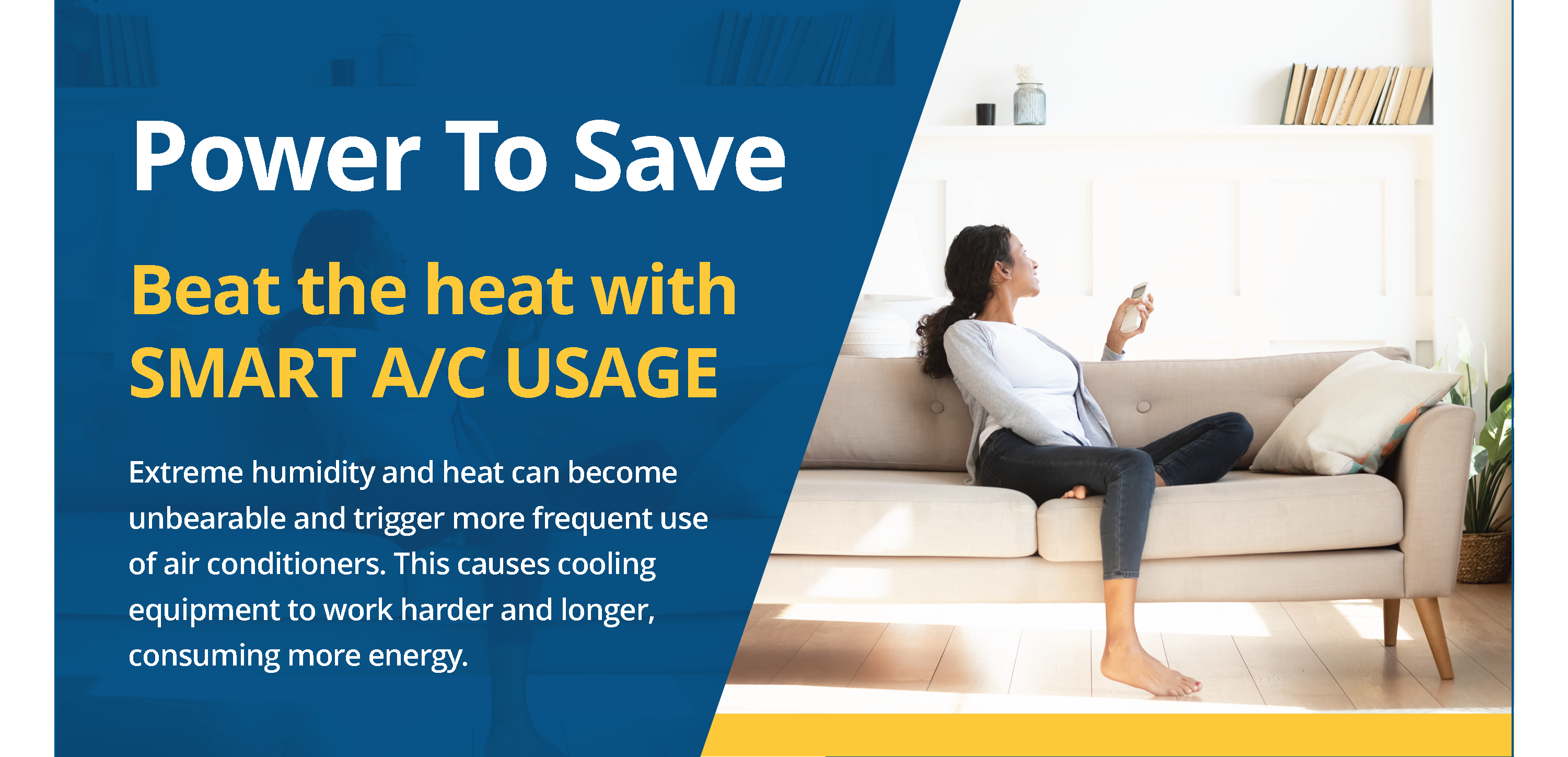
Extreme humidity and heat can become unbearable and trigger more frequent use of air conditioners. This causes cooling equipment to work harder and longer, consuming more energy. Here are some useful tips to help you be energy smart and stay cool.
Smart or programmable thermostats are a useful way to remotely regulate your home's temperature and cooling schedule with timers.
Set temperature to 78° or as high as comfort permits to balance energy savings and comfort.
Clean air filters frequently to prevent clogging, dust and dirt build-up.
Schedule regular maintenance to help your HVAC unit operate more efficiently.
Open all vents to optimize the flow of cool air and avoid overworking your system.
Choose the right A/C for your home. Check the cooling capacity based on the size of your space and select invertor or energy-efficient models.
Seal Air Leaks. Air conditioners require longer cooling times for rooms where air escapes. Add weather stripping to drafty vents, windows and doors.
Consider these additional comfort-enhancing and energy saving tips:
Use natural ventilation. Open windows and doors on breezy evenings.
Avoid using heat-generating appliances such as ovens, clothes dryer, hair dryers, etc., during the day.
Utilize ceiling and standalone fans to provide some cooling and comfort.
Close window coverings and blinds during the day to reduce heat from sunlight entering the home.
Consider home insulation to reduce energy demand and conserve cooling. This creates a barrier to heat gain in roofs, and walls.
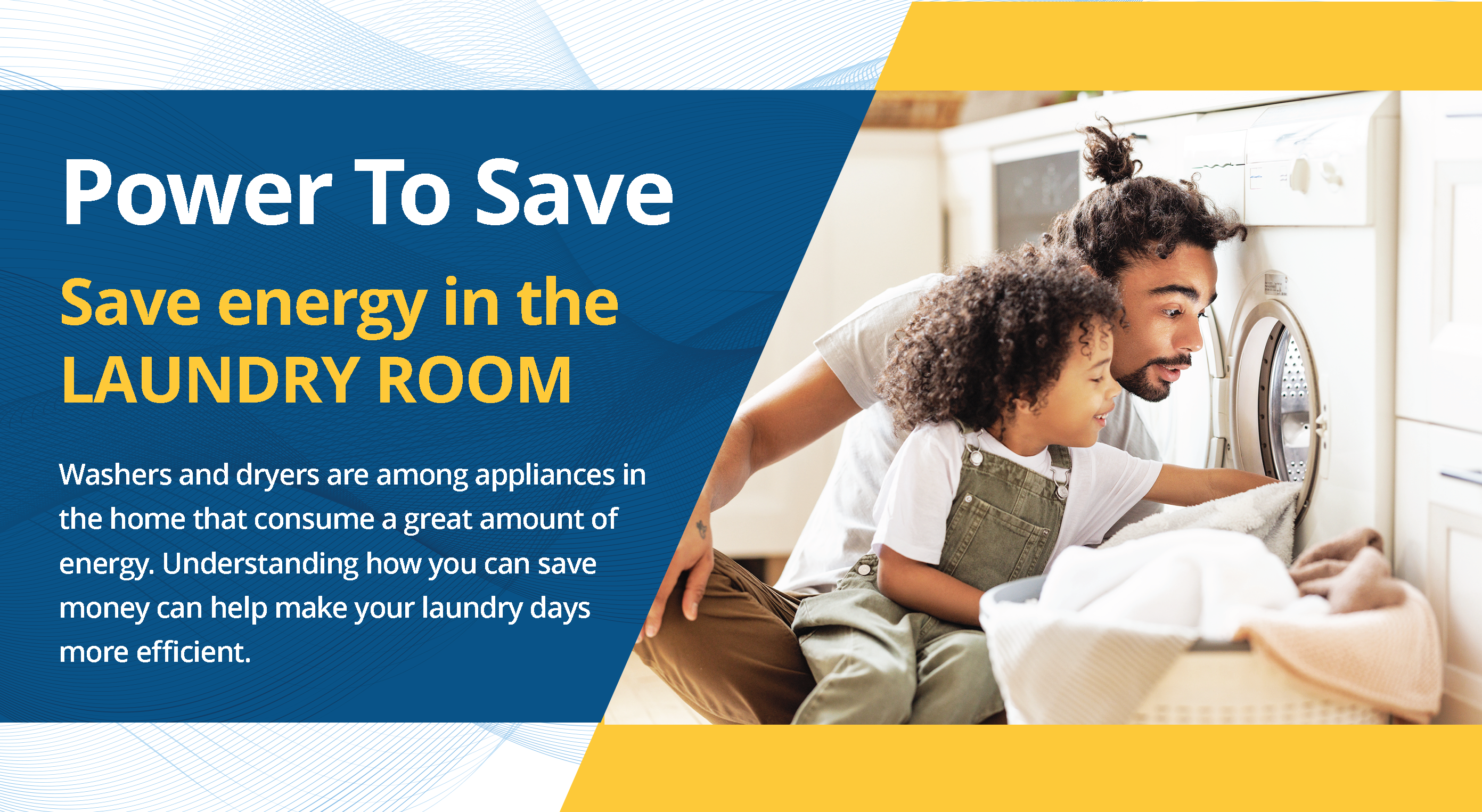
Saving energy comes in many forms. Washers and dryers are among appliances in the home that consume a great amount of energy. As an essential household task, understanding how you can save money with smart steps can help make your laundry days more efficient and reduce energy costs.
High speed or extended spin cycles extract more moisture from clothes, which helps to reduce the drying time.
Opt for cold water settings to eliminate the need for water heating.
Sort laundry by weight. Separate heavy towels, linens and clothes from lightweight fabrics for an even clean and a more efficient wash.
Opt out of using a dryer. Maximize the sun and consider air drying.
Clean the lint screen and dryer ducts to improve air circulation.
Dry right-sized loads for your machine. If the dryer is overloaded, it will extend the drying time and restrict the space for hot air circulation.
Avoid over drying clothes, which wastes electricity. The excessive heat can also cause shrinkage, warping and general wear and tear on clothes.
Follow a laundry schedule. Full loads and half loads consume the same amount of electricity. Only wash full loads to maximize the energy used in the cycle.
Out with the old. Consider newer, energy efficient washers and dryers if you can afford to. Older models are less efficient and use more power. Modern units allow for more customized wash and drying cycles, water level and heat controls, and are equipped with weight sensors for accurate loading, which improves energy efficiency.
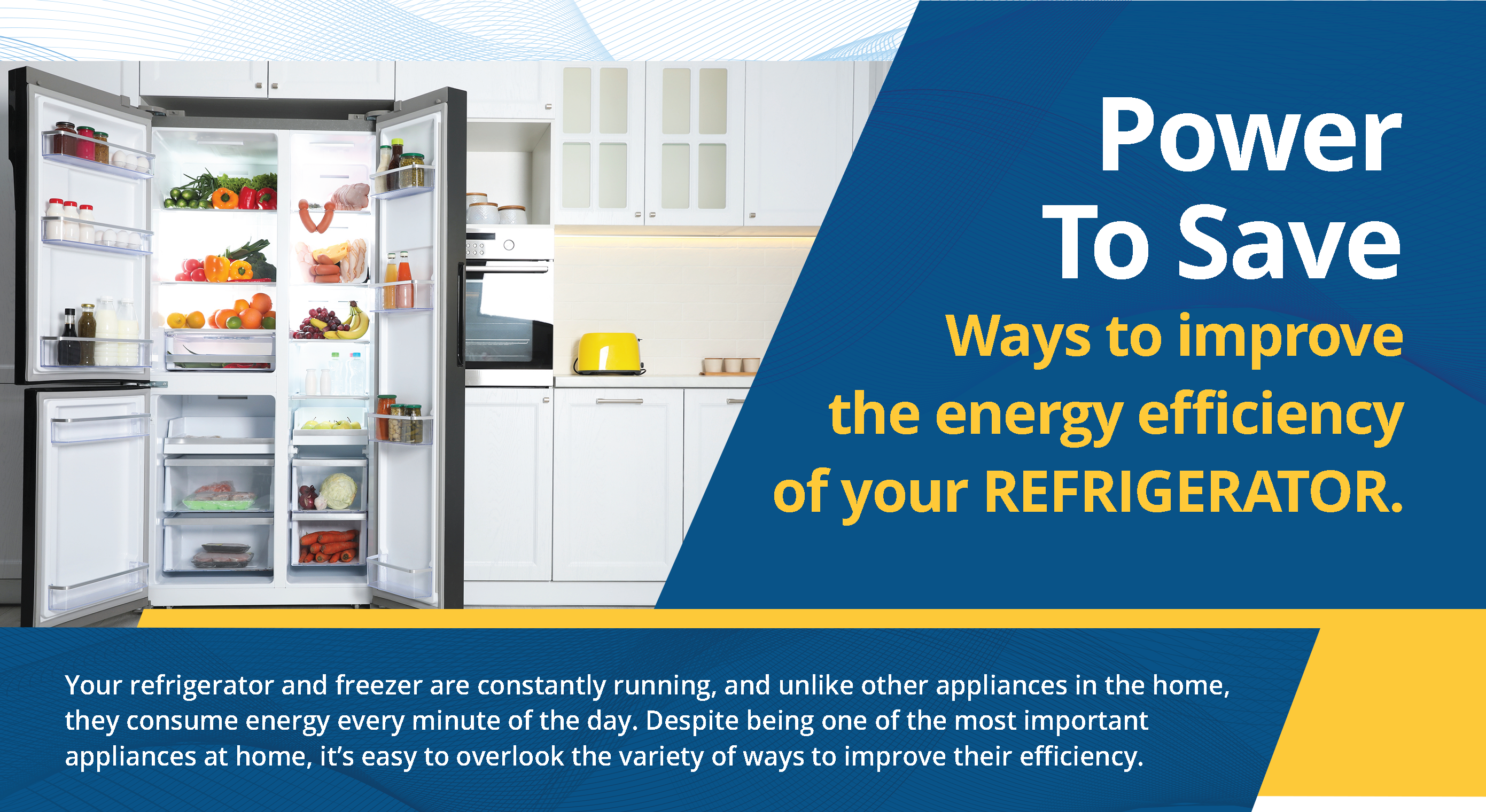
Your refrigerator and freezer are constantly running, and unlike other appliances in the home, they consume energy every minute of the day. Despite being one of the most important appliances at home, it’s easy to overlook the variety of ways to improve their efficiency. Here are steps you can take to make your unit run more efficiently.
Allow food to cool down. Placing hot food in the refrigerator adds heat to the interior. Allow food to reach room temperature before refrigeration.
Make space for good air flow. Ensure your refrigerator is at least two inches from the wall to allow air flow around condenser coils when heat is emitted.
Move your fridge away from high-heat sources. These include an oven, dishwasher, stove and windows with direct sunlight
Set the temperature for maximum efficiency. Choose a setting on your refrigerator that maintains 35 and 38 degrees Fahrenheit, and between 0 and 5 degrees on your freezer.
Reduce frost build-up. Layers of ice 1/4-inch-thick around your freezer means your unit uses more energy to cool the interior.
Clean condenser coils. These coils on the back or under your fridge can accumulate dust and debris overtime and make your unit work harder.
Check the door seals. Gaps, cracks, or tears in the rubber seal or gasket allows cold air to escape and warm air to enter the fridge. Replace the rubber seal if worn or torn as these can lose suction overtime.
Adjust the anti-sweat feature. Where available, turn on the power-saving switch for the anti-sweat feature in the fridge to limit the amount of times the door seals and exterior surface are heated to prevent condensation.
Retire old, aging refrigerator units for energy star-rated models if you can afford to, and save in the long-run. Remember to buy the right size refrigerator for your needs. A unit too large burns unnecessary energy.
Don’t store open containers. Placing open drinks and food containers in the fridge increases the internal moisture levels and makes the compressor work harder. Cover food with wrapping or Tupperware.

Are you looking for ways to reduce your electricity usage? Thinking carefully about how you prepare meals and use appliances around the kitchen can make a difference. Cooking is not something we can easily portion down, but making changes to your habits and handling of the oven and stove can help whip up less kilowatts per meal.
Match your pot size to your burner size as closely as possible. A small pan on a large burner wastes the burner’s heat.
Consider quick-cook and one pot dishes. Vegetables can be boiled alongside pasta. Meal planning can help you cook more efficiently and include low-energy, low-cost meals.
Practice batch cooking. If you must use an oven, take advantage of the shelves and cook as much food as possible at once.
Keep the oven door closed to prevent heat loss. Use the oven light to check your food’s progress through the glass door.
Use smaller appliances for smaller jobs. Use a toaster oven, microwave, slow cooker, electric pressure cooker or air fryer for reheating and faster cooking times.
Ditch the kitchen and grill outdoors. This is great for barbecuing as a zero-energy alternative, which also eliminates heat-build up in the home.
Avoid overcooking food. Leaving your rice, grits or pasta rolling for longer than necessary is wasted energy. Use a timer to stick to the correct cooking time.
Choose the right bakeware and cookware for the dish to optimize the cooking time.
Consider a gas stove over electric stove based on your preference, and remember to clean the heating rings to ensure power goes straight into the pot.
These steps will help you save energy by cooking more efficiently, and lowers the amount of heat emitted in the home while cooking, which helps you to save on cooling
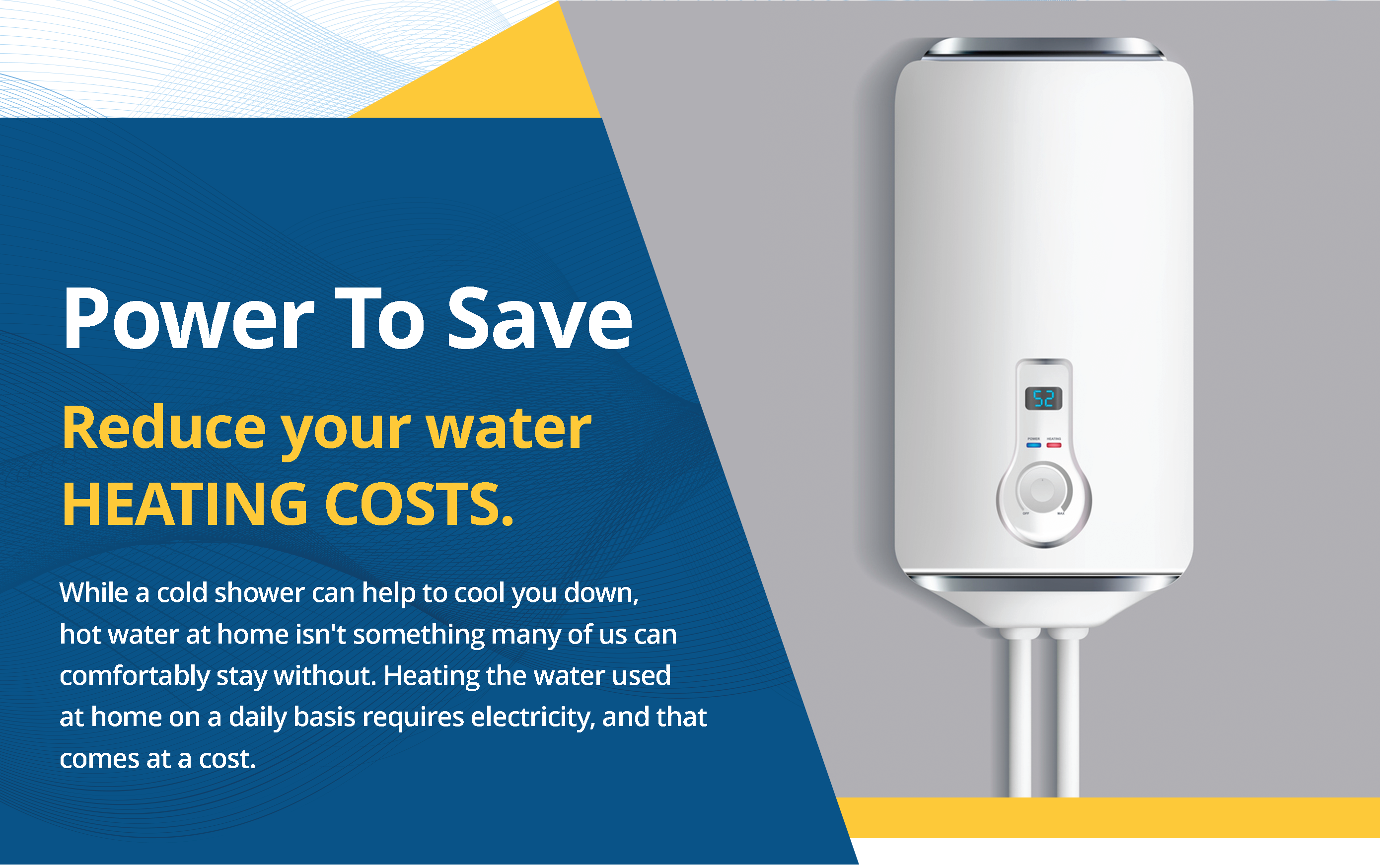
The summer days are sweltering, and while a cold shower can help to cool you down, hot water at home isn't something most of us can comfortably live without. Heating the water used at home on a daily basis requires electricity, and that comes at a cost. Follow these energy-efficient strategies to help you save on heating costs.
Use timers to reduce standby energy loss. Timers can allow you to pause the production and circulation of hot water when not at home.
Insulate Exposed Hot-Water Pipes. Water will arrive at the faucet a few degrees warmer, which reduces the time it takes to heat.
Read water heater labels. Labels show energy efficiency on a scale from A (most efficient) to G (least efficient). Choose wisely.
Switch to tankless water heaters. Unlike traditional water heaters, tankless water heaters provide hot water only when it is required and does not store water. If the tap is not turned on, the water is not heated.
Use less hot water. Install low-flow shower heads and faucet aerators to use less hot water altogether and save energy. Take showers instead of baths and repair leaky faucets. Use the economy setting on dishwashers and consider air drying dishes.
Regular Maintenance. If you are unable to switch from a tankless conventional storage-tank water heater, ensure your unit is maintained to offer to most efficient performance. Be aware of signs that your water heater needs professional attention or replacement.

One of the easiest ways to lower your energy cost is by paying attention to the lights around your home or commercial building. Leaving on lights unnecessarily coupled other energy-draining behaviors can take a toll on your consumption. With the right lighting solutions and smart habits, you can yield savings on energy costs.
- Switch off lights. Remember to turn off the lights when not in use. This is the simplest way to save energy and the only cost required is consistency.
Install timers and motion-sensors to prevent energy waste when lights are accidentally left on. Door lights, flood lights and other exterior lights with this feature also improves home security.
Smart lighting system. Smart bulbs and smart switches allow you the flexibility and convenience of remotely controlling lights across your home via a smart phone or voice assistant.
Task lighting consume less energy than overhead lighting fixtures and targets areas where you need illumination the most. These are useful in areas such as computer desks, over the stove, living rooms and bedside for reading.
Use natural light to your advantage. Utilize windows and skylights to keep your space naturally well lit. Consider moving computer desks closer to windows when working during the day.
Position switches for easy access. Install lights near entry and exit point to make it easier to switch off when not in use.

Activate power-saving mode. Switch devices such as computers, monitors, and copiers to use sleep mode or energy saver mode when not in use.
Unplug electronics that are not in use to save energy to avoid wasting energy and prevent damaging the battery life.
Choose laptops and tablets over computers. Laptops typically use significantly less energy and tablets have even lower energy usage than laptops.
Use a power strip to reduce phantom power. Plug electronic devices into a power bar and program it to switch off at night. Televisions, and game consoles absorb energy even when they’re not in use.
Lower screen brightness. The higher the brightness on your screen the more power is used.
Consider the size and type of TV. If you are buying a television, choosing an energy-efficient LED screen will save you energy.
Set a sleep timer. If you often fall asleep whilst watching TV, set a timer to turn off your TV when it’s been idle.
Switch off controllers when not in use to avoid wasting energy.
Avoid streaming through game consoles. When streaming your game console uses more energy compared to laptops or tablets.
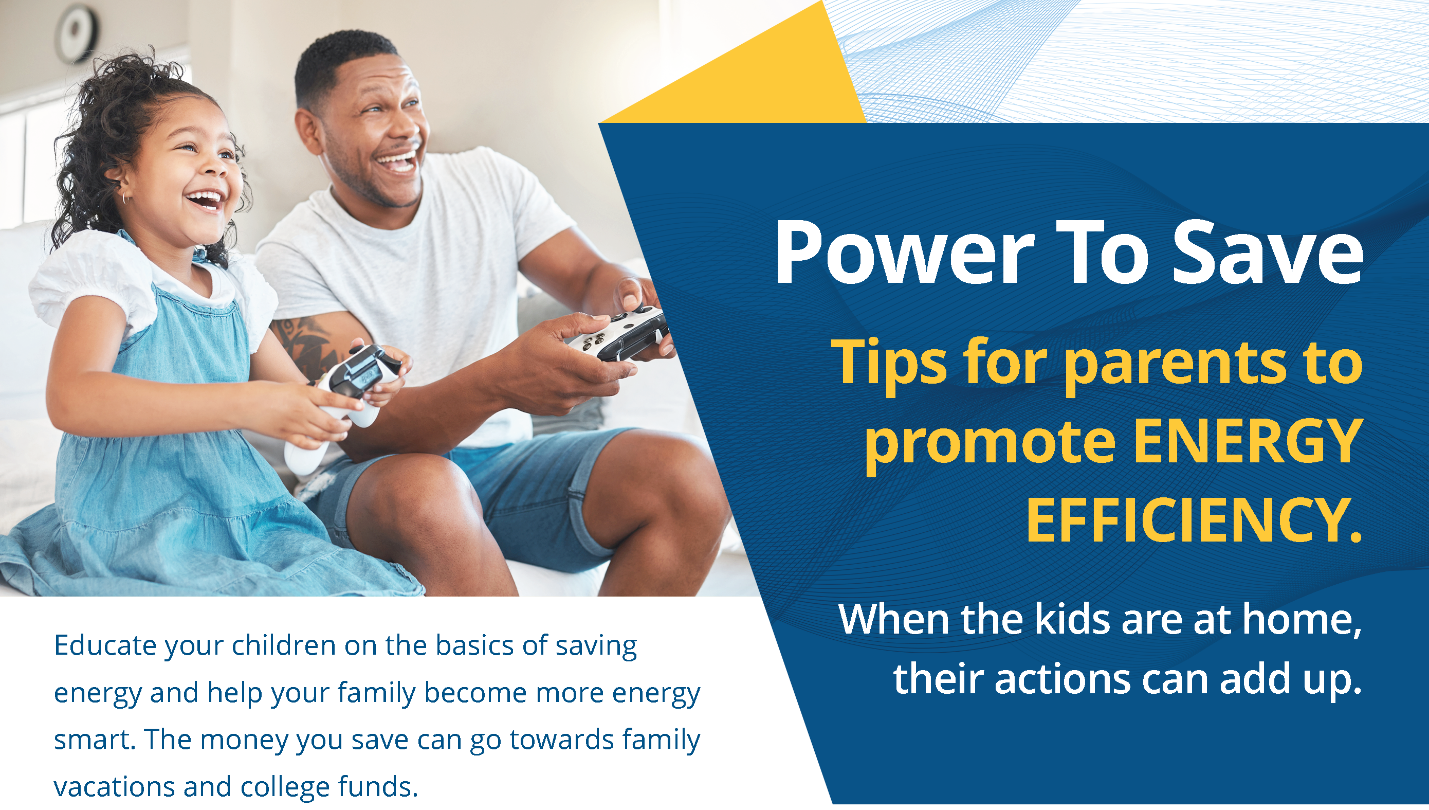
We’ve scoured and assembled some useful tips to get you started.
Limit kid’s gadget time. Spend less time watching TV, playing video games and using the Internet and more time with energy-free activities. Consider board games, reading a book, cycling or creating art. Give them a sticker and treats for their efforts.
Shower with timers. Discourage baths and long showers and encourage energy efficiency by putting a 3-5-minute timer in the bathroom for more controlled showers and to save on water and heating costs.
Install jingle bells on doors. Get creative and hang a bell on door handles as a reminder to close the door. This prevents precious cool air from escaping the home and warm air from entering.
Open/Close Fridge Rule. Encourage children to think about what they want before opening the fridge, and post a sign on the fridge that reads, “don’t leave me open,” as a fun reminder.
Choose tablets and laptops over TV’s. During movie time, use smaller gadgets such as IPADS or tablets that can operate on their own for hours.
Use smaller appliances for meals. Use the microwave, sandwich makers, or air fryers for kitchen adventures and preparing quick meals. This emits less heat during the day when temperatures are highest.
Utilize Natural Light. Discourage your loved ones from turning on lights during daylight hours. Create a checklist of items to be turned off each time they leave a room such as lights, game consoles, computer, television and wall switches.
During daylight hours. Choose air drying. After a fun day at the beach or pool, hang wet towels and swimsuits outdoor on a porch or balcony in the sunshine to dry naturally as opposed to using a washer and dryer.
Wear lightweight, light-colored clothes at home to stay comfortable and reduce the tendency to turn on the air conditioner for relief.
Stay cool without A/C. Close shades, drapes, and blinds during the day to prevent sunlight from entering and heating the home. Use a ceiling or standalone fan and open windows on cool evenings.
Plant a tree. Plant a tree to help shade your house on hot summer days, and is a great space to spend time outdoors.
After the successful completion of a three-year partnership with the Tu... Read More